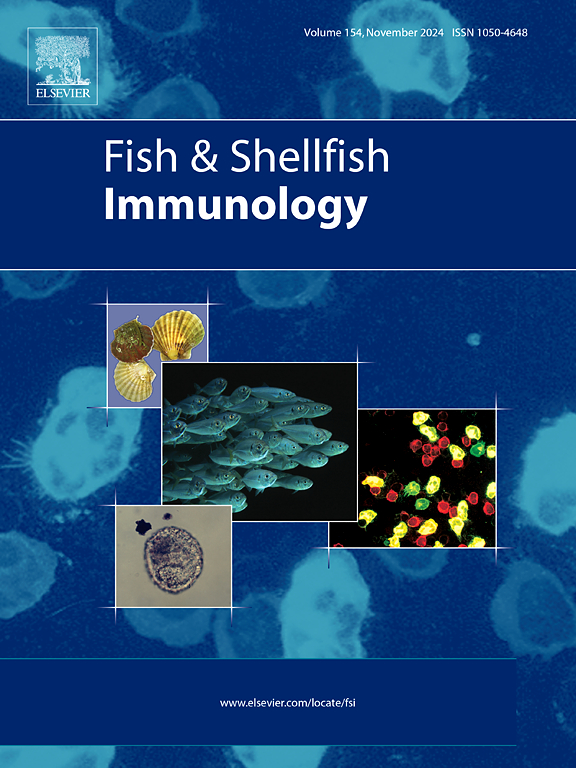Comparative analysis on antioxidant capacity, immunity and histopathological changes of largemouth bass (Micropterus salmoides) in response to mono- or co-infection with Aeromonas veronii and Nocardia seriolae
IF 3.9
2区 农林科学
Q1 FISHERIES
引用次数: 0
Abstract
Previous research has found that largemouth bass co-infected with Aeromonas veronii and Nocardia seriolae caused quicker and higher mortality than those infected by one single bacteria. Whereas, the pathogenic mechanism of co-infection with A. veronii and N. seriolae is still unclear. To explore this reason, the bacterial load in liver, spleen and head kidney, as well as the antioxidant capacity, non-specific immunity, histopathological changes and gene expression profiles of largemouth bass were both investigated and comparatively analyzed following mono- and co-infections. The results revealed that the total amount of A. veronii and N. seriolae in liver, spleen and head kidney of co-infected fish was significantly (P < 0.05) higher than that of every single infected fish at 7th and 14th days post-infection (dpi). Meanwhile, the activities of SOD, GSH-Px, AKP and LZM were remarkably (P < 0.05) decreased in infected fish, whereas the CAT and ACP capacities were increased. Moreover, the expression levels of immune-related genes in the spleen and head kidney increased initially and then decreased during 96 h after infection, whereas apoptosis-related genes showed a continuous rise. Especially, the mRNA profile of genes from co-infected fish was higher than that of each single infected fish at the time when the maximum expression appeared. In addition, the liver, spleen, head kidney and intestine of largemouth bass exhibited severe tissue lesions after infection. Particularly, the degree of damage in co-infected fish was more serious than that of each single infected fish. The results will advance our knowledge on the interaction between pathogenic bacteria and host immune system during mono- or co-infection with A. veronii and N. seriolae, and then help to develop management strategies to mitigate the impact of bacterial infection on largemouth bass production.
大口黑鲈(Micropterus salmoides)对维罗氏气单胞菌和seriolae诺卡菌单、共感染的抗氧化能力、免疫和组织病理学变化的比较分析。
以往的研究发现,同时感染维罗氏气单胞菌和斯诺卡菌的大口黑鲈比感染一种细菌的大口黑鲈死亡率更快、更高。然而,维罗氏单胞菌和瑟雷弗菌共感染的致病机制尚不清楚。为了探究这一原因,本研究对大口黑鲈单次感染和双次感染后肝脏、脾脏和头肾的细菌负荷、抗氧化能力、非特异性免疫、组织病理变化和基因表达谱进行了比较分析。结果显示,在感染后第7天和第14天,共感染鱼的肝脏、脾脏和头肾中韦氏单胞杆菌和梭状奈希菌的总数显著(P < 0.05)高于单独感染鱼。同时,SOD、GSH-Px、AKP和LZM活性显著(P < 0.05)降低,CAT和ACP活性显著升高。感染后96 h,脾和头肾免疫相关基因表达量先升高后降低,而凋亡相关基因表达量持续升高。特别是在最大表达量出现时,共感染鱼的基因mRNA谱高于单个感染鱼。感染后,大口黑鲈的肝脏、脾脏、头肾和肠道均出现严重的组织病变。特别是,共感染鱼的损害程度比单个感染鱼更严重。该研究结果将有助于我们进一步了解维氏弧菌和瑟氏奈瑟菌单独或共同感染大口黑鲈时致病菌与宿主免疫系统的相互作用,从而有助于制定管理策略以减轻细菌感染对大口黑鲈生产的影响。
本文章由计算机程序翻译,如有差异,请以英文原文为准。
求助全文
约1分钟内获得全文
求助全文
来源期刊

Fish & shellfish immunology
农林科学-海洋与淡水生物学
CiteScore
7.50
自引率
19.10%
发文量
750
审稿时长
68 days
期刊介绍:
Fish and Shellfish Immunology rapidly publishes high-quality, peer-refereed contributions in the expanding fields of fish and shellfish immunology. It presents studies on the basic mechanisms of both the specific and non-specific defense systems, the cells, tissues, and humoral factors involved, their dependence on environmental and intrinsic factors, response to pathogens, response to vaccination, and applied studies on the development of specific vaccines for use in the aquaculture industry.
 求助内容:
求助内容: 应助结果提醒方式:
应助结果提醒方式:


